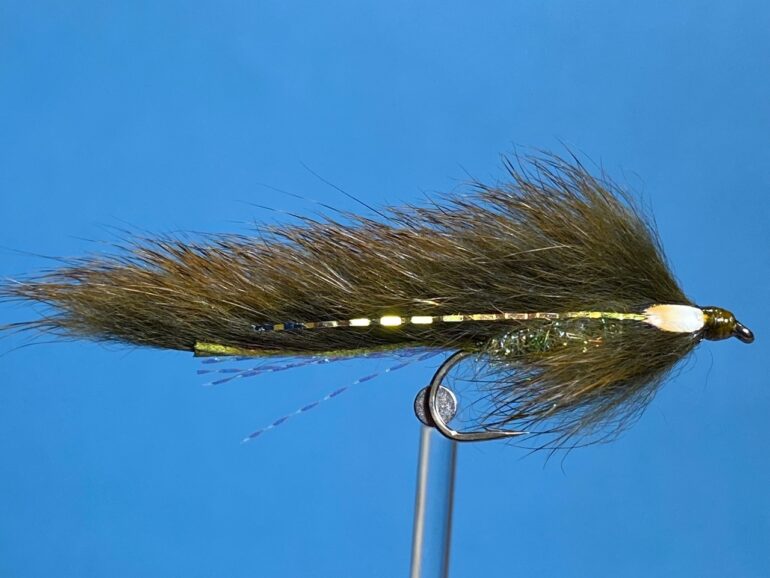
A Fly To Tie & Try October 2023 – The Pine Squirrel Zonker by Les Lockey
Fly of the Month – Oct
The Pine Squirrel Zonker
Hook: Kamasan B800 longshank lure hook, size 10.
Underbody: Fine lead wire.
Thread: Olive Roman Moser Powersilk, 10/0.
Tail: Olive Krystal Flash with olive pine squirrel zonker strip over.
Back: Olive pine squirrel zonker strip.
Body: Olive UV Ice Dub and olive Glister mixed .
Collar Hackle: Olive pine squirrel zonker strip.
Side flashes: Peacock Black Krinkle Mirror Flash, (optional).
Eyes: Jungle cock nails or 3mm stick on eyes.
TYING
Photo 1. Secure the hook in the vice and starting about 3mm from the eye, wind on a bed of thread to a point opposite the barb and remove the waste thread. Apply a light coat of superglue to the thread wraps from opposite the hook point to the start of the thread, then wind on tight turns of lead wire over the glue, stopping at the thread starting point.
Photo 2. For the under tail, take 3 strands of Krystal Flash, double them over so the tips are aligned and with the tips extending about the same length as the hook shank, tie them in securely on top of the shank, and remove the excess Krystal Flash. Now cover the wire with thread, leaving the thread at the tail. This will take several passes up and down the shank.
Photo 3. At the bottom end of the squirrel zonker strip and with moistened fingers, part the fur strip equal in length to the under tail. Place the parting on top of the shank and tie it down securely with three tight thread turns, then make two locking thread turns onto the shank immediately in front of the zonker strip tie in point.
Photo 4. Lay the zonker strip back over the tail and dub the ice dub mix onto the thread. Wind the dubbing noodle along the shank forming a tapered fat carrot shape stopping at the thread tie in point.
Photo 5. Bring the zonker strip forward over the dubbing, and with moistened fingers, part the fur in line with the end of the body and under tension, tie the strip down securely and centrally onto the bare hook shank and continue to take the thread to the eye.
Photo 6. Keeping the zonker strip taught and square to the shank, rotate it away from the hook through 90 degrees and begin to wind the strip on as a collar for 2 or 3 turns, stroking the fibres rearward after each turn. Secure the strip at the eye with several tight turns of thread. Carefully cut away the excess zonker strip and tidy the area with thread.
Photo 7. With lightly moistened fingers, stroke the collar fibres rearward to help flatten the fibres near the eye, then tie in a length of Mirror Flash along one side of the body to extend the full length of the fly. Now take the excess Mirror Flash and bring it around the head to the other side of the fly and tie it down securely, before trimming the Mirror Flash to length.
Photo 8. Tidy the area with a few turns of thread, then tie in one jungle cock nail feather on each side of the head, so the eyes line up centrally along the shank, then remove the waste jungle cock stems.
Photo 9. Form a neat head, whip finish, and remove the thread. Varnish the head to complete the fly.
Tying Tips
- When tying zonker patterns, I like to use a strong GSP type of tying thread such as Roman Moser’s Powersilk or Semperfli Nanosilk which are both strong but very fine. This allows me to secure the zonker strips to the hook shank with very tight turns of thread without any significant build-up of thread.
- Starting the thread 3mm from the eye acts as a guide to where the body should finish in order to leave enough space for the collar and head.
- When covering the lead wire with thread, use acutely angled turns of thread across the wire wraps. This prevents the thread from slipping down between the turns of wire.
- Pine Squirrel is one of my favourite tying materials. Its thin skin has short dense fibres, making it ideally suited for tying small lures and wet flies, while the fur makes an excellent dubbing.
- Use moistened fingers to part the fur. This keeps the parting open and free from straggly fibres of fur, and also allows the thread to be tied directly on to the skin of the zonker strip which increases the security of dressing.
- When tying in the zonker strip there is a tendency for the strip to be pushed around the hook as the first turn of thread is made, so to counteract this, I position the skin on the side of the shank and allow the first turn of thread to rotate the strip into position on top of the shank. Further turns of thread can then be cinched down tightly to keep the strip in place.
- When winding fur strips around a hook shank, it is normally suggested that crosscut zonker strips are used, however, pine squirrel zonker strips are so soft and finely cut, they can easily be used to wind collars, so long as the strip is kept taught, square to the hook and held at a 90 degree angle to the shank before winding. For smaller patterns, or if you have difficulty in winding the zonker strip, the fur can be cut from the skin, inserted into a dubbing loop and spun to produce a fur rope which can then be wound as a fur hackle.
- I prefer jungle cock nail feathers for the eyes of this pattern, but as an alternative, 3 or 4mm artificial eyes could also be used. Just stick them in position with superglue, cover with UV resin and cure with a torch.
Fishing Hints
- The very first time I tried this fly at Coldingham was 5 years ago as I drifted out of Swing Gate Bay into Lochside Bay. I had just attached the pine squirrel zonker to my leader and cast my long midge tip fly line towards the overhanging willow tree near Lochside cottage and before I had the chance to start a retrieve, the line just shot away. A few hectic minutes later, I netted a beautiful 5lb brown.
- This pattern was originally used as a river fly on a small overgrown stream near Manchester airport where it accounted for many large and wily brown trout, but it also works well as a stillwater pattern particularly when fry are on the menu.
- The pattern can be fished at any time of year and on any density line, but it seems to work best for me at Coldingham during late September and into October, fished on a long midge tip line around structure and over old decaying weed beds, where it often picks out the bigger fish. As a result, I prefer to fish this pattern as a single fly to reduce the chance of snagging.
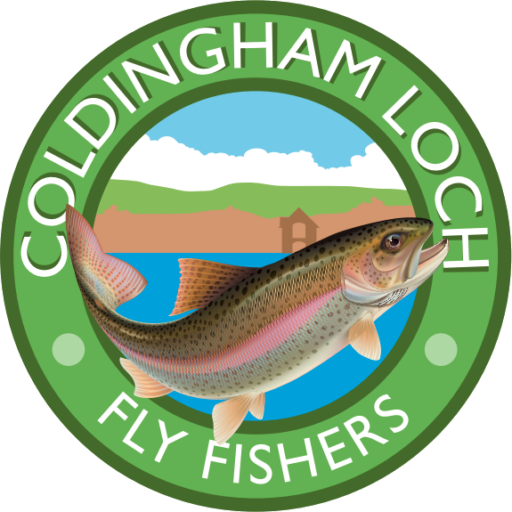


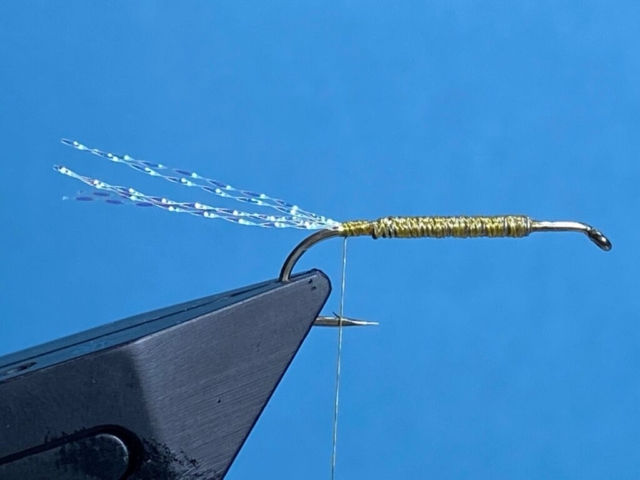



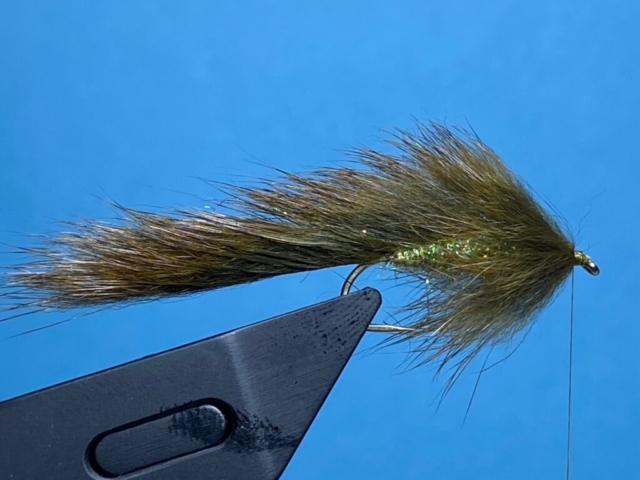

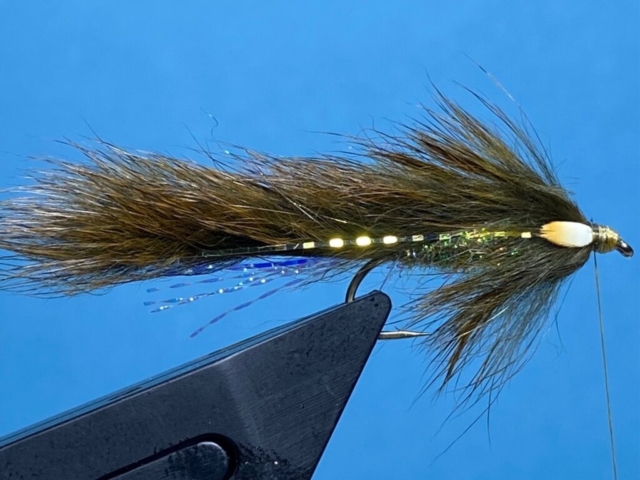


Recent Comments